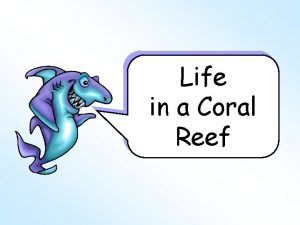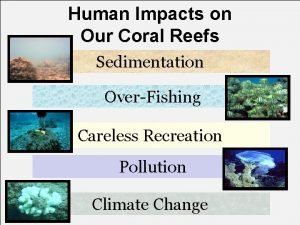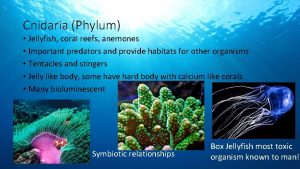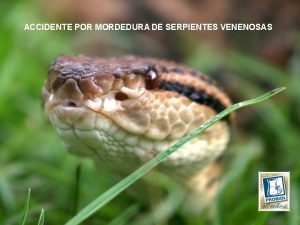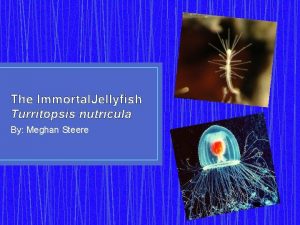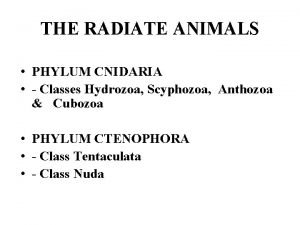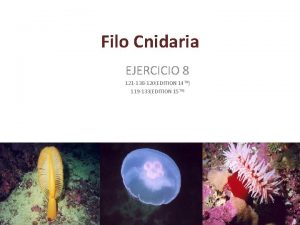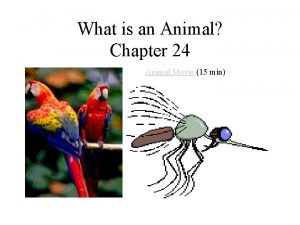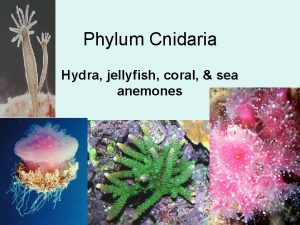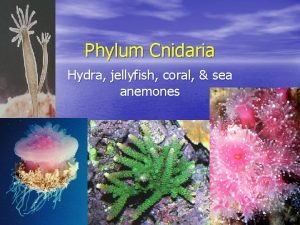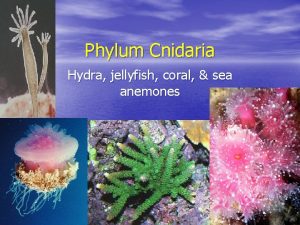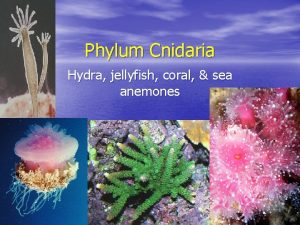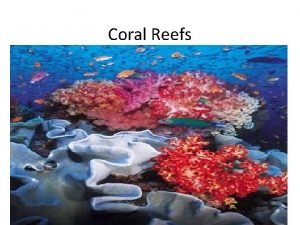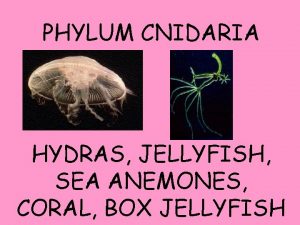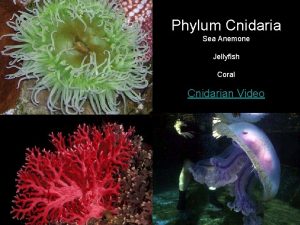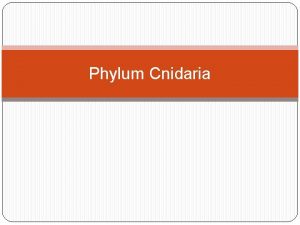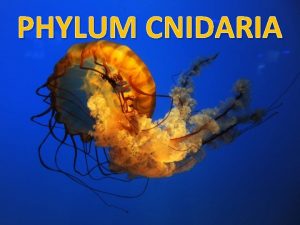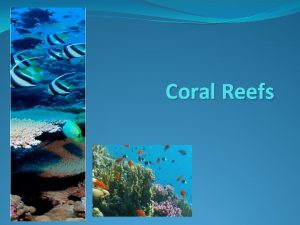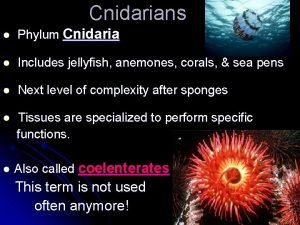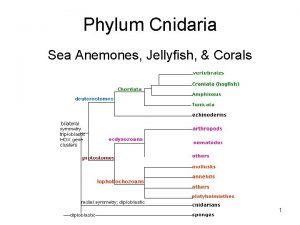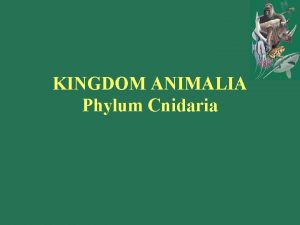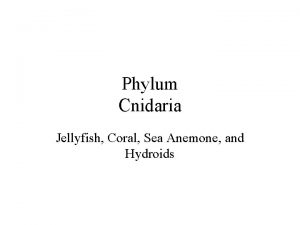Cnidaria Phylum Jellyfish coral reefs anemones Important predators






















- Slides: 22

Cnidaria (Phylum) • Jellyfish, coral reefs, anemones • Important predators and provide habitats for other organisms • Tentacles and stingers • Jelly like body, some have hard body with calcium like corals • Many bioluminescent Symbiotic relationships Box Jellyfish most toxic organism known to man!

Crustaceans (Phylum) • Crabs, lobsters, shrimp, barnacles • Hard outer shell • Some have jointed legs, others are attached to rocks • Some have claws, others have specialised filters Pistol shrimp shoots out bubble over 4, 000°C

Echinoderms (Phylum) • Starfish, sea cucumbers, sea urchins • Body plan arranged into 5 parts (Like a star) • Hydraulic pressure used for movement • Have tube feet for movement Crown of thorns starfish destroys corals

Molluscs (Phylum) • Octopus, cuttlefish, squid, mussels, sea slugs, sea snails • Arms and tentacles with suckers • Shells or beaks for protection or feeding • Some can camouflage, or release ink as an alarm response Blue Dragon Sea Slug eats Jellyfish stings and uses them for Humboldt protection ! Squid has toothed suckers!

Vertebrates • Have a backbone • Counter Shading for camouflage • More complex animals • • • Circulatory System Respiratory System Digestive System Skeletal System Nervous System • Why is it important to study them? • Often at top of food chains, control populations of prey • Act as prey for larger organisms, important food items for humans

Adaptation: Countershading Dark Topside camouflages against dark depths from animals looking down from above Sneak up on prey and don’t get eaten! White underside breaks up figure against light flickering down

Can you think of any others with this colouration?

Chondrichthys (Class) • Cartilaginous Fish • Skates, Rays, Sharks • Scales called Denticles • Protection • Less hydrodynamic resistance • Either have fins or rays • Important top predators

Osteichthyes (Class) • Bony Fish • Seahorses, soles, swordfish, tuna, and many more… • Bony skeletons • Scales cover body The sailfish is the fastest fish in the sea! • Fin Rays • Steering • Stability • Flying! Enlarged fin rays make wings so flying fish can fly away from predators

Mammals (Orders) The Blue Whale is the largest animal to ever live! • Whales, dolphins, seals, sea lions, walruses, dugongs, polar bears, sea otters • Warm blooded (endothermic) • Thick layer of blubber • Protection • Insulation • Energy Storage • Melon on head for echolocation, produce clicks like bats • Lungs and blowholes, need to breathe air!

Activity Classification Game Worksheet • Using the key, classify the 8 organisms through the different levels based on their characteristics

Answers: • Animal • Cubozoa • Chirodropidae • Chironex • Fleckeri • Box Jellyfish

Answers: • Animal • Echinoderm • Asteroidea • Valvatida • Acanthasteridae • Acanthaster • Planci • Crown of thorns starfish

Answers: • Animal • Crustacean • Malacostraca • Decapoda • Portunidae • Carcinus • Maenas • Shore Crab

Answers: • Animal • Mollusc • Cephalopoda • Octopodidae • Hapalochlaena • Lunulata • Greater Blue Ringed Octopus

Answers: • Animal • Echinoderm • Echinoidea • Echinoida • Echinidae • Echinus • Esculentus • Edible Sea Urchin

Answers: • Animal • Mollusc • Cephalopoda • Teuthida • Loliginidae • Loligo • Vulgaris • Common Squid

Answers: • Animal • Scyphozoa • Semaeostomeae • Pelagiidae • Chrysaora • Colorata • Purple Striped Jellyfish

Answers: • Animal • Crustacean • Malacostraca • Decapoda • Nephropidae • Homarus • Gammarus • Common Lobster

Where to go from here? • This is just an introduction, many other marine species and groups • Smaller organisms like plankton also very important • Different lifecycle stages and behaviours • Plants and seaweeds also important • Deep Sea, burrowing organisms and polar seas • Marine Technology • So much to discover!

Plenary Slides 1. What characteristics can we use to identify organisms? 2. What two classification levels do we use in scientific names? 3. Give 2 reasons why classification is important 4. Why are invertebrates important in the marine environment? 5. Which cnidarians are often used as habitats? 6. Which organisms have a body plan arranged into 5 parts? 7. How do many marine organisms use colour as camouflage? 8. What functions do shark denticles have? 9. What organ do marine mammals use for echolocation? 10. What is the fastest fish in the sea?

Answers: 1. Morphology (Shape), Colour, Behaviour, Genetics 2. Genus and Species 3. Distinguish organisms, identify factors affecting species, show relationships between species, make sure you are talking about the same species with others 4. Used for food, responsible for ecosystem structure 5. Anemones and Corals 6. Echinoderms 7. Countershading and bioluminescence 8. Reduce hydrodynamic drag and protection 9. Melon 10. Sailfish
 Jellyfish
Jellyfish Life cycle of coelenterata
Life cycle of coelenterata Coral reefs biome
Coral reefs biome Coral reefs caribbean studies
Coral reefs caribbean studies Competition in coral reefs
Competition in coral reefs Detailed lesson plan about coral reefs
Detailed lesson plan about coral reefs Coral reef scavengers
Coral reef scavengers Coral notes
Coral notes Does overfishing affect coral reefs
Does overfishing affect coral reefs Competition in coral reefs
Competition in coral reefs Cnidaria predators
Cnidaria predators Un acidente
Un acidente Immortal jellyfish order
Immortal jellyfish order Man o war habitat
Man o war habitat Phylum cnidaria general characteristics
Phylum cnidaria general characteristics Cnidaria characteristics
Cnidaria characteristics Cnidocytes jellyfish
Cnidocytes jellyfish General characteristics of cnidaria
General characteristics of cnidaria Characteristics of cnidarians
Characteristics of cnidarians Scyphozoa
Scyphozoa What are cnidocytes?
What are cnidocytes? Coral reef food chain
Coral reef food chain Asymmetrical
Asymmetrical






